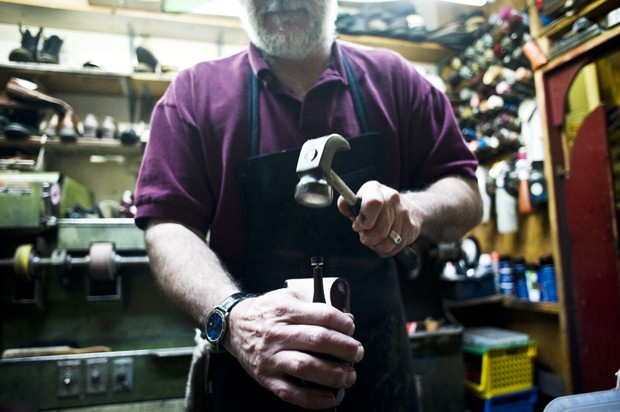Her heel broke on her favorite pair of gold, strappy heels. Preparing to graduate this spring, English senior Kiranjeet Kaur desperately wanted to find a place that would fix them. ThatâÄôs when she turned to Jim Picard , owner of Fast EddieâÄôs Shoe Repair & Care in Dinkytown . Located at 1316 Fourth St. S.E., Fast EddieâÄôs repairs backpacks, purses, belts, sandals, shoes, boots and other items. Picard said since the recession, he has seen a substantial increase in the number of customers seeking to fix their shoes instead of simply throwing them away. According to the Shoe Service Institute of America , a trade association for the shoe repair industry, shoe repair is among the oldest forms of recycling. Each year, the shoe repair industry keeps more than 62 million pairs of shoes out of landfills and on consumers’ feet . Picard said shoe repair shops tend to do better during recessions, noting his last increase in business was during the recession in the 1980s. He said people want to keep their shoes in good condition if they donâÄôt want to spend the money on a new pair. Fixing anywhere from 100 to 200 pairs of shoes a week, he said business in February âÄî normally one of his slowest months âÄî âÄúwas not quiet.âÄù âÄúWhere other businesses are having a tougher time in this economy, we had probably one of the biggest Februarys ever,âÄù he said. He said his clientele range from University of Minnesota students seeking to fix shoes or a broken strap on their backpack to construction workers looking to maintain steel-toe boots. âÄúIâÄôm need-based,âÄù he said. âÄúPeople come when they have issues, so they seek me out more so than me having to seek them.âÄù Picard said he has not had to increase prices at his store, but said the only change that has hit him because of the economy is the price increase for materials, such as the Italian leather he uses. âÄúI just swallow those increase costs, only because I have more customers,âÄù he said. As Kaur anticipates graduation and the return of her broken pair of high heels to wear during commencement, she said she wishes she would have known about shoe repair before, instead of throwing away her old, broken shoes. âÄúI never thought getting shoes repaired was such an easy thing and cheap,âÄù said Kaur. âÄúIf I would have known that, I probably would have gotten a whole ton of other shoes fixed before throwing them out.âÄù
How it all began
In the summer of 1936, Eddie LaPlante and his brother traveled to Crookston, Minn., searching for jobs. Both LaPlante and his brother found a shoe repairman who gave them a place to stay, but only if they would fix shoes. When World War II began, LaPlante took an army train to Georgia to serve but was unable to, because of flat feet. On his way home from Georgia, he saw a shoe repair shop seeking help in Minneapolis. During the war, shoes were hard to come by, so LaPlante opened his own shoe repair shop on Central Avenue. In 1971, Jerry Manes , owner of the Campus Cobbler Shoe Store in Dinkytown, asked LaPlante to come to Dinkytown. LaPlante opened his shop in a suite of what was previously the College Inn Hotel. In 1979, Picard came to Dinkytown as the manager of the Campus Cobbler . Picard said shoe stores and repair shops work together, so he worked closely with LaPlante. In 1985, Picard convinced LaPlante to sell him the store. In 1987, LaPlante decided he wanted to retire, but Picard convinced him to stay longer to teach him the craft of shoe repair. LaPlante stayed another 20 years, sharing with Picard his knowledge and expertise of the craft. âÄúI love what I do,âÄù Picard said. âÄúI take a lot of pride in what I turn out.âÄù


